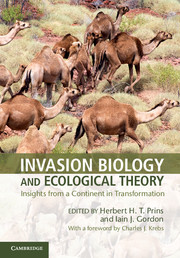Refine listing
Actions for selected content:
2285 results in Ebooks in ecology and environment

Invasion Biology and Ecological Theory
- Insights from a Continent in Transformation
-
- Published online:
- 05 February 2014
- Print publication:
- 23 January 2014
7 - Combination Methods for Turbulent Fluxes
-
- Book:
- Transport in the Atmosphere-Vegetation-Soil Continuum
- Published online:
- 05 June 2014
- Print publication:
- 31 January 2014, pp 252-277
-
- Chapter
- Export citation
Preface
-
- Book:
- Transport in the Atmosphere-Vegetation-Soil Continuum
- Published online:
- 05 June 2014
- Print publication:
- 31 January 2014, pp xi-xii
-
- Chapter
- Export citation
2 - Available Energy: Net Radiation and Soil Heat Flux
-
- Book:
- Transport in the Atmosphere-Vegetation-Soil Continuum
- Published online:
- 05 June 2014
- Print publication:
- 31 January 2014, pp 13-68
-
- Chapter
- Export citation
8 - Integrated Applications
-
- Book:
- Transport in the Atmosphere-Vegetation-Soil Continuum
- Published online:
- 05 June 2014
- Print publication:
- 31 January 2014, pp 278-301
-
- Chapter
- Export citation
6 - Vegetation: Transport Processes Inside and Outside of Plants
-
- Book:
- Transport in the Atmosphere-Vegetation-Soil Continuum
- Published online:
- 05 June 2014
- Print publication:
- 31 January 2014, pp 200-251
-
- Chapter
- Export citation
Index
-
- Book:
- Transport in the Atmosphere-Vegetation-Soil Continuum
- Published online:
- 05 June 2014
- Print publication:
- 31 January 2014, pp 431-436
-
- Chapter
- Export citation
Appendix E - Crop Factors for Use with Makkink Reference Evapotranspiration
-
- Book:
- Transport in the Atmosphere-Vegetation-Soil Continuum
- Published online:
- 05 June 2014
- Print publication:
- 31 January 2014, pp 362-362
-
- Chapter
- Export citation
4 - Soil Water Flow
-
- Book:
- Transport in the Atmosphere-Vegetation-Soil Continuum
- Published online:
- 05 June 2014
- Print publication:
- 31 January 2014, pp 133-176
-
- Chapter
- Export citation
Appendix C - Dimensional Analysis
-
- Book:
- Transport in the Atmosphere-Vegetation-Soil Continuum
- Published online:
- 05 June 2014
- Print publication:
- 31 January 2014, pp 356-358
-
- Chapter
- Export citation
3 - Turbulent Transport in the Atmospheric Surface Layer
-
- Book:
- Transport in the Atmosphere-Vegetation-Soil Continuum
- Published online:
- 05 June 2014
- Print publication:
- 31 January 2014, pp 69-132
-
- Chapter
- Export citation
References
-
- Book:
- Transport in the Atmosphere-Vegetation-Soil Continuum
- Published online:
- 05 June 2014
- Print publication:
- 31 January 2014, pp 409-430
-
- Chapter
- Export citation
Answers
-
- Book:
- Transport in the Atmosphere-Vegetation-Soil Continuum
- Published online:
- 05 June 2014
- Print publication:
- 31 January 2014, pp 363-402
-
- Chapter
- Export citation
1 - The Atmosphere-Vegetation-Soil System
-
- Book:
- Transport in the Atmosphere-Vegetation-Soil Continuum
- Published online:
- 05 June 2014
- Print publication:
- 31 January 2014, pp 1-12
-
- Chapter
- Export citation
5 - Solute Transport in Soil
-
- Book:
- Transport in the Atmosphere-Vegetation-Soil Continuum
- Published online:
- 05 June 2014
- Print publication:
- 31 January 2014, pp 177-199
-
- Chapter
- Export citation
Appendix D - Microscopic Root Water Uptake
-
- Book:
- Transport in the Atmosphere-Vegetation-Soil Continuum
- Published online:
- 05 June 2014
- Print publication:
- 31 January 2014, pp 359-361
-
- Chapter
- Export citation
List of Main Symbols
-
- Book:
- Transport in the Atmosphere-Vegetation-Soil Continuum
- Published online:
- 05 June 2014
- Print publication:
- 31 January 2014, pp 403-408
-
- Chapter
- Export citation
Appendix A - Radiation
-
- Book:
- Transport in the Atmosphere-Vegetation-Soil Continuum
- Published online:
- 05 June 2014
- Print publication:
- 31 January 2014, pp 345-347
-
- Chapter
- Export citation
Frontmatter
-
- Book:
- Transport in the Atmosphere-Vegetation-Soil Continuum
- Published online:
- 05 June 2014
- Print publication:
- 31 January 2014, pp i-iv
-
- Chapter
- Export citation
9 - Integrated Models in Hydrology and Meteorology
-
- Book:
- Transport in the Atmosphere-Vegetation-Soil Continuum
- Published online:
- 05 June 2014
- Print publication:
- 31 January 2014, pp 302-344
-
- Chapter
- Export citation
